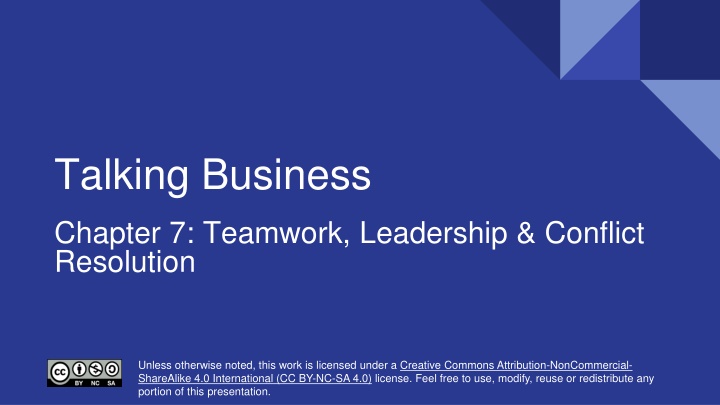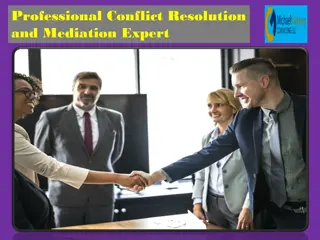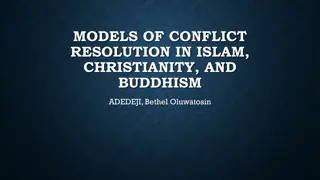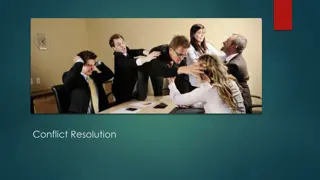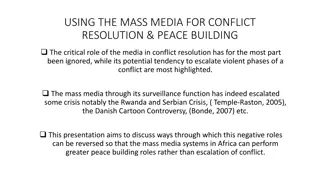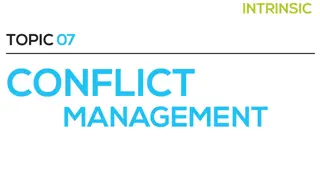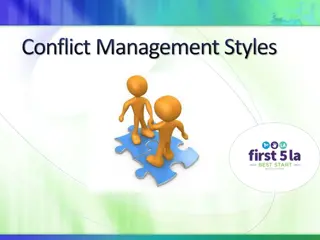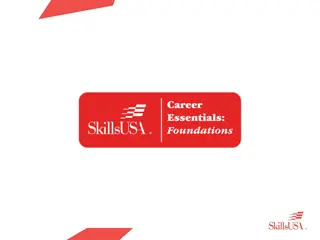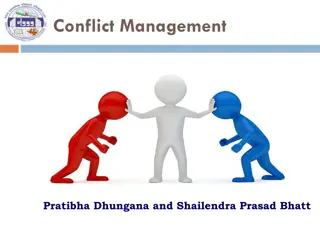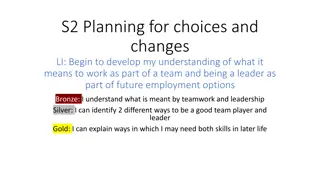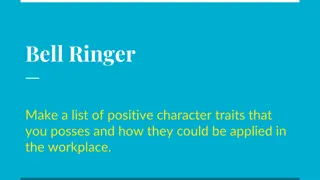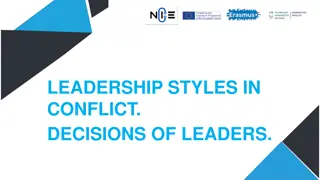Teamwork, Leadership & Conflict Resolution in Business
Understanding the dynamics of groups and teams is crucial for effective teamwork, leadership, and conflict resolution in a business environment. This chapter delves into defining groups and teams, exploring group life cycles, member roles, leadership styles, and strategies for resolving workplace conflicts. By learning about these aspects, individuals can enhance their ability to work collaboratively, lead effectively, and manage conflicts professionally.
Download Presentation

Please find below an Image/Link to download the presentation.
The content on the website is provided AS IS for your information and personal use only. It may not be sold, licensed, or shared on other websites without obtaining consent from the author.If you encounter any issues during the download, it is possible that the publisher has removed the file from their server.
You are allowed to download the files provided on this website for personal or commercial use, subject to the condition that they are used lawfully. All files are the property of their respective owners.
The content on the website is provided AS IS for your information and personal use only. It may not be sold, licensed, or shared on other websites without obtaining consent from the author.
E N D
Presentation Transcript
Talking Business Chapter 7: Teamwork, Leadership & Conflict Resolution Unless otherwise noted, this work is licensed under a Creative Commons Attribution-NonCommercial- ShareAlike 4.0 International (CC BY-NC-SA 4.0) license. Feel free to use, modify, reuse or redistribute any portion of this presentation.
Learning Outcomes At the end of this chapter, learners will be able to: Define groups and teams. Identify the typical stages in the life cycle of a group. Describe types of group members and group member roles. Describe teamwork and how to overcome challenges to group success. Describe leadership styles and their likely influence on followers. Describe several strategies for resolving workplace conflict related to evaluations and criticism. Explain the types of conflict.
7.1 What is a Group? A group may be defined as three or more individuals who affiliate, interact, or cooperate in a familial, social, or work context. Group communication may be defined as the exchange of information and meaning between three or more people. Photo by Peggy und Marco Lachmann-Anke, Pixabay License
7.1 What is a Group? Two Types of Groups: primary and secondary Primary groups meet most, if not all, of one s needs. Groups that meet some, but not all, needs are called secondary groups. Photo by StockSnap, Pixabay License
7.2 Group Life Cycles and Member Roles Group Life Cycle Patterns Forming: Members come together, learn about each other, and determine the purpose of the group. Storming: Members engage in more direct communication and get to know each other. Conflicts between group members will often arise during this stage. Norming: Members establish spoken or unspoken rules about how they communicate and work. Status, rank, and roles in the group are established. Performing: Members fulfill their purpose and reach their goal. Adjourning: Members leave the group Figure 7.1. Tuckman s Linear Model of group development
7.2 Group Life Cycles and Member Roles Life Cycle of Member Roles Curiosity and interest Potential Member Joined the group but still an outsider and unknown New Member Full Member Knows the rules and is looked to for leadership Focuses on differences Divergent Member No longer involved Marginal Member No longer considered a member Ex-Member Table 7.1 Life Cycle of Member Roles
7.2 Group Life Cycles and Member Roles Positive and Negative Member Roles Suggests new ideas or new ways of looking at the problem Dominates discussion, not allowing others to take their turn Initiator- Coordinator Dominator Builds on ideas and provides examples Relates discussion to their accomplishments; seeks attention Recognition Seeker Elaborator Brings ideas, information, and suggestions together Relates discussion to special interest or personal agenda Special-Interest Pleader Coordinator Evaluates ideas and provides constructive criticism Blocks attempts at consensus consistently Evaluator- Critic Blocker Records ideas, examples, suggestions, and critiques Seeks attention through humour and distracts group members Recorder Joker or Clown Table 7.2 Positive Roles Table 7.3 Negative Roles
7.3 Group Problem Solving Define the Problem Analyze the Problem Establish Criteria Consider Possible Solutions to the Problem Decide on a Solution Implement the Solution Follow Up on the Solution Figure 7.2. Problem-solving process
7.4 Teamwork and Leadership Teams are a form of group normally dedicated to production or problem solving. When setting up a team: Select team members wisely Select a responsible leader Promote cooperation Clarify goals Elicit commitment Clarify responsibilities Instill prompt action Apply technology Ensure technological compatibility Provide prompt feedback
7.4 Teamwork and Leadership Leadership is a complex of beliefs, communication patterns, and behaviours that influence the functioning of a group and move a group toward the completion of its task. Leadership Styles: Autocratic leaders set policies and make decisions primarily on their own, taking advantage of the power present in their title or status to set the agenda for the group. Democratic leaders facilitate group discussion and like to take input from all members before making a decision. Laissez-faire leaders take a hands-off approach, preferring to give group members freedom to reach and implement their own decisions.
7.5 Conflict in the Work Environment Conflict is the physical or psychological struggle associated with the perception of opposing or incompatible goals, desires, demands, wants, or needs (McLean, 2005). Conflict Management Strategies: Avoidance Defensiveness versus Supportiveness Face-Detracting and Face-Saving Empathy Managing Your Emotions Evaluations and Criticism in the Workplace Listen without Interrupting Determine the Speaker s Intent Indicate You Are Listening Paraphrase If You Agree/ If You Disagree Learn from Experience
7.6 Conflict Management in Todays Global Society Avoidance: Conflict? What Conflict? Competition: My way is the only way. Accommodation: Whatever you want is okay with me. Collaboration: Let s solve this problem together! Compromise: Meet me in the middle. Triggers and Self-monitoring Enhancement The PIN Model of Conflict Strategies for Handling and Preventing Conflict Emotions and Our Developing Brain Figure 7.3: Conflict Management Styles by Fanshawe College, CC BY-NC-SA 4.0
7.7 Crucial Conversations While the process may be the same, high- stakes communications require more planning, reflection, and skill than normal day-to-day interactions at work. In addition, be aware of your communication style and practice flexibility; it is under stressful situations that communication styles can become the most rigid. Photo by Joseph Mucira, Pixabay License
Reflection Activity Returning to Abe s story from the beginning of this chapter, as a leader on the technology side of her team s work, how might she share what she knows without overwhelming other team members? What type of leadership style would help Abe have a positive impact on her team s success implementing the new software required for Financial Analysts?
